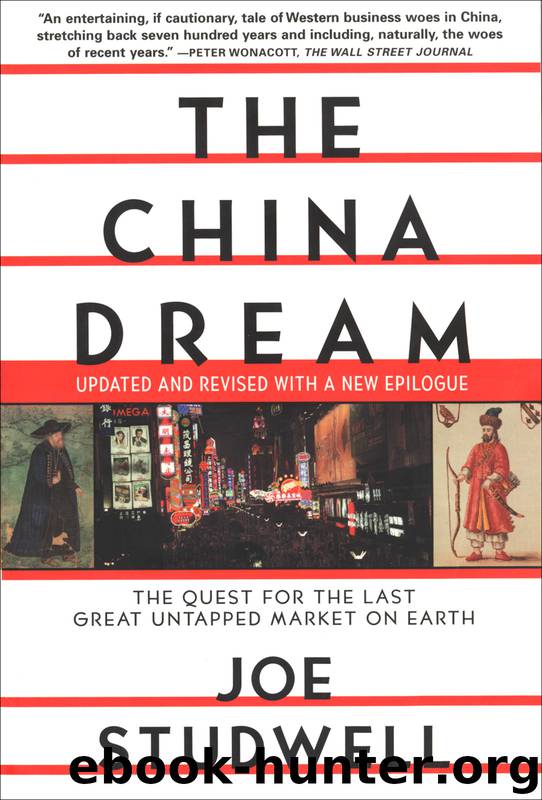The China Dream by Joe Studwell

Author:Joe Studwell
Language: eng
Format: epub
Publisher: Grove Atlantic
Published: 2002-03-13T16:00:00+00:00
Jurassic Park
If the Chinese government was unable to control its bureaucrats, it was equally unable to contain the broader state sector. Just as the number of apparatchiks grew during the reform period, so did that of employees in state industry. In 1978 the non-administrative state sector had an official payroll of 75 million people; this had risen by the late 1990s to over 112 million. There were millions more people who were not on the official ‘state-owned units’ payroll but were none the less direct employees of state-controlled companies; it is quite possible, adding in an appropriate portion of collective workers, that in 2000 actual state sector employment was as high as 200 million.64 The government talked the language of downsizing – and the outside world bought into this – but in reality the majority of urban inhabitants at the end of the decade were public servants.
The government’s inability to get to grips with its vast state sector was nowhere more conspicuous than in its antipathy to bankruptcy. China’s bankruptcy rate in the late 1990s was at most 0.05 per cent of companies per year – one-twentieth the level of the United States.65 A decade after the country enacted a bankruptcy law in 1988, only 16,000 businesses had gone to the wall. Most of these were not state-owned enterprises but private firms, collectives and foreign-invested companies. Even when a state company was bankrupted, the process was often a sham. In 1996, the Chinese state media trumpeted the biggest bankruptcy to date, that of the 18,000-worker Shanxi Textile Dyeing Plant. It was reported that in this model insolvency case the assets of the business had found a ready purchaser which had paid $59 million and hired many of the redundant employees. The buyer turned out to be another state company set up specifically for the purpose of the acquisition by the provincial authorities. At other times, central government reached for bankruptcy where it faced claims from foreign creditors. In January 1999, Guangdong International Trust and Investment Corp., which foreign banks had fallen over themselves to lend to in the early 1990s, was put into liquidation. It, and its sister company Guangdong Enterprises, owed creditors – mostly overseas institutions – $10 billion; they were expected to wait years to receive around 20 cents on the dollar.
Throughout the 1990s there was talk in government circles of a new law, one which would facilitate a higher level of bankruptcies by increasing the rights of creditors. The drafting of legislation began in the middle of the decade, but five years later no law had been put before the National People’s Congress for ratification.66 The central government was unnerved by the implications for unemployment and the banking system, which would have to write off huge losses. The state fell back instead on a ‘rationalisation’ policy that involved few bankruptcies and limited numbers of real redundancies. None the less, the post-1997 premier, Zhu Rongji, claimed in 1998 that he could ‘solve’ the public sector problem within three years.
Download
This site does not store any files on its server. We only index and link to content provided by other sites. Please contact the content providers to delete copyright contents if any and email us, we'll remove relevant links or contents immediately.
International Integration of the Brazilian Economy by Elias C. Grivoyannis(92318)
The Radium Girls by Kate Moore(11935)
Turbulence by E. J. Noyes(7944)
Nudge - Improving Decisions about Health, Wealth, and Happiness by Thaler Sunstein(7622)
The Black Swan by Nassim Nicholas Taleb(7016)
Rich Dad Poor Dad by Robert T. Kiyosaki(6415)
Pioneering Portfolio Management by David F. Swensen(6231)
Man-made Catastrophes and Risk Information Concealment by Dmitry Chernov & Didier Sornette(5926)
Zero to One by Peter Thiel(5694)
Secrecy World by Jake Bernstein(4653)
Millionaire: The Philanderer, Gambler, and Duelist Who Invented Modern Finance by Janet Gleeson(4386)
The Age of Surveillance Capitalism by Shoshana Zuboff(4216)
Skin in the Game by Nassim Nicholas Taleb(4166)
Bullshit Jobs by David Graeber(4104)
The Money Culture by Michael Lewis(4083)
Skin in the Game: Hidden Asymmetries in Daily Life by Nassim Nicholas Taleb(3935)
The Dhandho Investor by Mohnish Pabrai(3706)
The Wisdom of Finance by Mihir Desai(3659)
Blockchain Basics by Daniel Drescher(3511)
